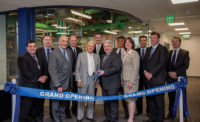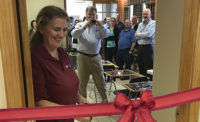Smithfield Supply debuts plumbing training center
“Everything in this industry changes so fast,” he says. “It’s tough for a salesperson to keep up on it, let alone a contractor.”

Two current major industry topics of discussion are attracting new talent and employee-customer training.
On the labor front, check out my story in this month’s issue. for a look at what some proactive PHCP-PVF distributors are doing to attract new talent into their companies.
And one need not look any further than the state of Rhode Island for a key example of how a distributor is taking training to the next level — right under its own roof.
Smithfield Plumbing and Heating Supply is a 40-year-old distributor of plumbing, heating, air-conditioning and septic products with four locations and one showroom in Rhode Island and New Hampshire. The company was started by Rico Colaluca and now is run by his son, Aaron, who has been with the company for 24 years.
“We’re pretty hands on,” Aaron Colaluca says. “My father started out as a master plumber with my uncle in the trade before opening a supply house. I also went to plumbing school and earned my master plumber’s license in Rhode Island. I worked in the trade to gain a better understanding of how the hands-on portion of the industry works before coming to Smithfield Supply.”
That hands-on philosophy is part of the impetus behind Smithfield (a member of the Omni buying group) opening its own training center at its corporate headquarters in Smithfield, R.I.
“We thought there was a need for something like this,” Colaluca says. “All these companies bring trailers around with live-fire units to train people on certain days. Why not make our own and do it whenever there is a need for whatever boiler or HVAC unit. When there is a need at that particular moment we can use the room.”
The training room is set up in a way where products from multiple disciplines can easily be switched in and out. Colaluca says constantly changing technologies played a key role in hatching the idea for the training room. “Everything in this industry changes so fast,” he says. “It’s tough for a salesperson to keep up on it, let alone a contractor.”
Smithfield goes as far as to ask manufacturers for the defective products it turns in so they can be used as live case studies in the room. “If there was a bad board or a bad pressure switch, we’ll send it back to the factory and then ask for it back,” he says. “We can do a whole training class on that particular product. That way our customers are going into a real-world environment with a product that isn’t working just like it would be if they were on a jobsite.”
The room took about six weeks to build and was constructed by Smithfield employees and even some customers. Colaluca lauded the efforts of Rhode Island branch employee Bill D’Agostino, who brought everybody together and kept the training room on track. “We asked for a lot of input from the various vendors we have in there,” Colaluca says. “It was a big community project.”
In addition to boilers, the room can accommodate mini-splits, furnaces, in-floor radiant (complete with a Plexiglas floor so customers can see its inner workings) and schematics on pumps. A water-treatment class also was recently held. “You show people this boiler is good for three gallons a minute and then you can show them how running multiple showers can affect the water pressure,” Colaluca says. “It’s not learning out of a book. We’re hands-on with how we learn.”
Thus far, the response to the room has been strong, but Colaluca is proud of one particular metric concerning the project. “I like to hear people talk about it through third parties,” he explains. “People always say thank-you when they leave a class. But when you start hearing from someone that Tommy said the class was amazing, that’s the type of feedback you want. This person took the time to tell someone else how good it is and now I’m hearing that secondhand.”
Having this type of training available benefits not only Colaluca’s customers but his employees as well. Colaluca notes Smithfield employees are among those attending seminars in the room. “You have to be there to stand behind your guy — the contractor,” he says. “Here, service is the only thing we have to offer. You can buy something everywhere. With us, you are talking to someone who has a technical background and truly can help you.”
And helping each other throughout the supply chain is what will continue to move our industry forward in the coming years.
This article was originally titled “Everybody wins” in the September 2016 print edition of Supply House Times.
Looking for a reprint of this article?
From high-res PDFs to custom plaques, order your copy today!






